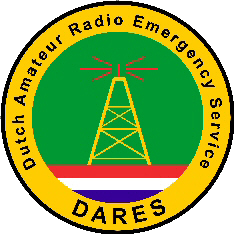

DARES is an Dutch alternative that makes it possible (as is in America (ARES), Great Britain (Raynet), en Belgium (Radio Noodnet)) for Dutch Licensed Radio Amateurs to participate "organized help" in emergency circumstances, where there is no communication possible by normal mains. Under "organized help" you must understand that our organization has made rules for conducting emergency communication, which are made with the local and national government. Our goals can be read here
In the starting phase of DARES i was involved in the development of the organization. After i had some time management problems i pulled myself back to regional management of the local group, where the people are who do the job.
The organization of DARES consists out of three layers; The top layer is the national coordination with the station PI9D. Then there is the second layer where the coordination in the region is. A region is the same as the national safety region for emergency departments, and there are 22 of them. As last there are the local groups. They are consisting out of several Radio amateurs, who can be put in action on local area's and are in charge of the actual communications
The group of Bergen Op Zoom (dutch), where i'm the coordinator of, consists out of several Radio Amateurs en SWL's who regularly training (nation wide as local) and conducting little test's. For this purpose i have put togeher a crash kit
It's is NOT the intention that Emergency traffic must take a hierarchic route
It might be sensible in these circumstances to contact the local groups or the region coordinator, and follow the instructions of those stations. The local group is specialized to forward information quickly to parties concerned. It is explicit NOT the case that the concerned Radio Amateur who is involved in Emergency traffic, do not take part in the further exchange of information. I fact he/she will explicit take part in the communication, guided by the local group or region coordinator.
If an radio operator is in a emergency situation they can go to the following frequencies. The second frequency will be used as an alternative.
On 2 meter: 145.225 MHz (145.275 MHz) or locale repeater
On 70 cm: 433.225 MHz (433.275 Mhz) or locale repeater
Lets hope that Emergency traffic will not be necessary in the future, but it can't hurt to be prepared. It's also a nice way to practice this hobby, and also can be lots of fun.